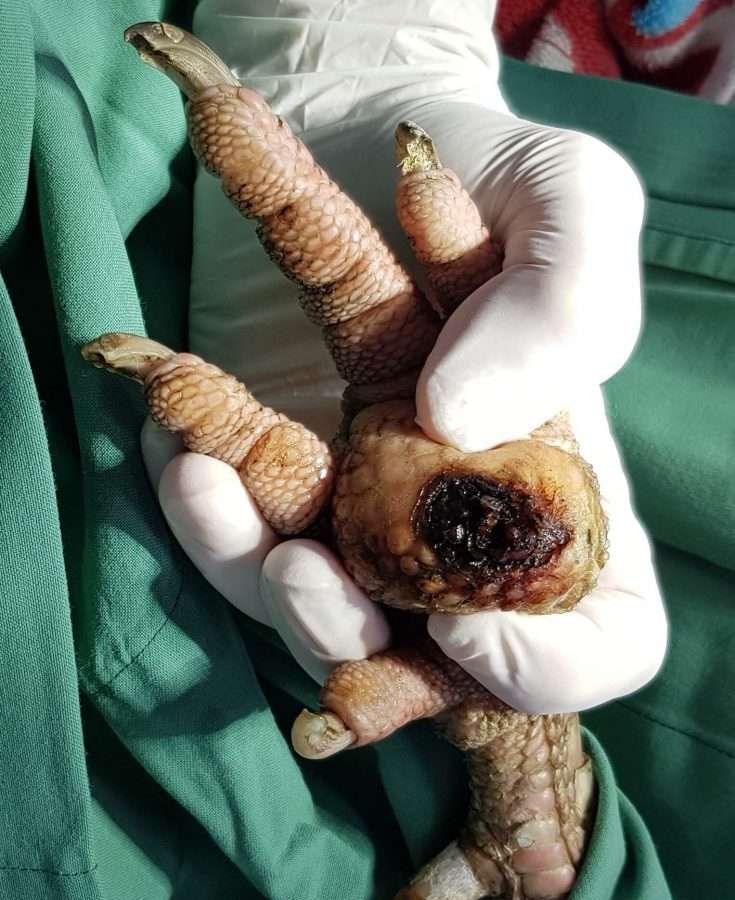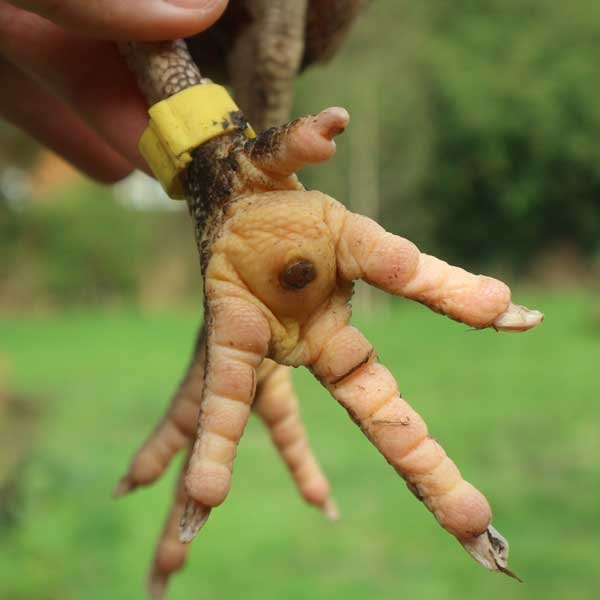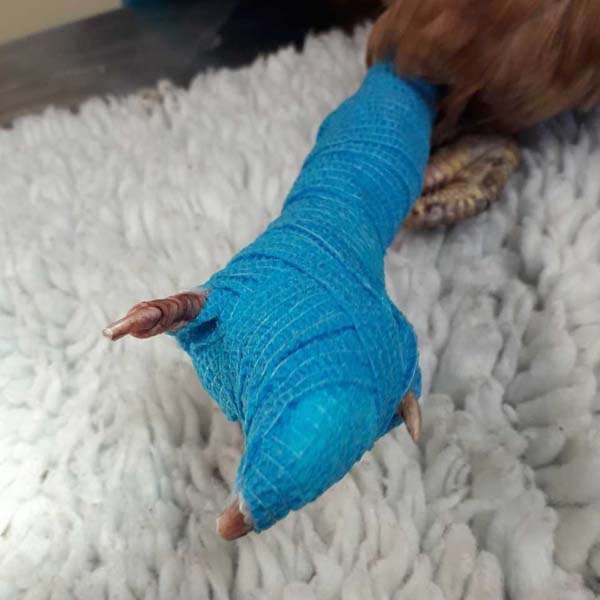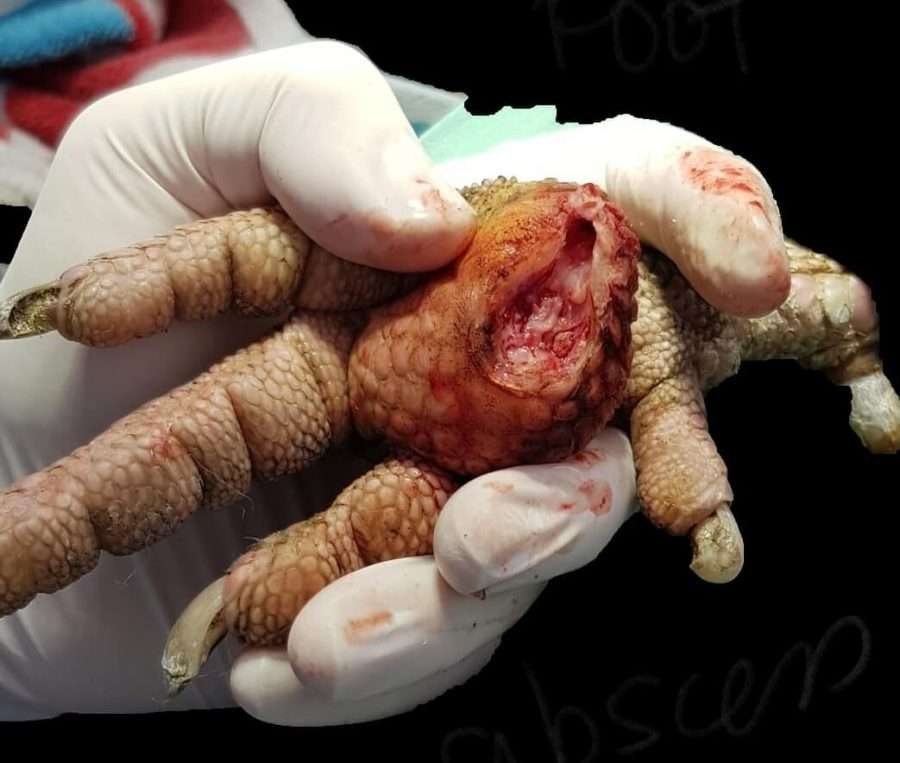
Bumblefoot in chickens, also known as Pododermatitis, is a common condition arising from injury to the bottom of a chickens foot. Chickens’ feet can become scratched or cut from their everyday activities, result in infection and present as bumblefoot. Bumblefoot can be easily treated, however it can also often be overlooked and left untreated which may result in pain and even death in chickens where it is left untreated for too long. In this article we will teach you the signs of bumblefoot and how it can be treated quickly and effectively.
What this article covers
Below are some quick links. Click any of them to go straight to the section you are interested in – or just carry on reading for the full article!
Causes of bumblefoot in chickens
How to prevent bumblefoot in chickens
Is it bumblefoot?
Your chicken may have bumblefoot if you notice the following symptoms –
- Limping or putting more weight on a particular foot (the unaffected foot)
- Decreased physical activity
- Avoiding using a particular leg or foot completely
- Swelling of the foot
- A black or brown hard lump or scab in the middle of your chickens footpad, top of foot or toes
The black or brown scab or lump on your chickens footpad is generally the main giveaway that your chicken is suffering from bumblefoot. This scab forms when your chickens foot has sustained an injury like a scratch to their foot, which has then become infected, scabbed over and is full of an infected pus core/plug/kernel underneath the foots skin.

Causes of bumblefoot in chickens
The development of bumblefoot is usually the result of a foot injury such as a cut, scratch, graze or puncture that then left undetected and untreated, becomes infected through bacteria in the chickens environment.
Generally this initial injury will be so minor that most of the time it is undetectable – unless you are inspecting your chickens feet closely every day! Lets face it though the majority of us chicken owners don’t do this!
Common chicken foot injuries that lead to bumblefoot usually result from unsuspecting hazards in the coop or run or even just from everyday normal chicken activity such as:
- Stepping on something sharp like chicken wire or exposed metal
- Scratching their feet against rough or sharp surfaces like gravel
- Jumping down from heights onto something rough that scratches their feet
- Splinters from rough roosts or wood chips used in the coop or run
- Foraging in rough ground containing rock or wood chips
These hazards and foot injuries combined with bacteria in their living environment such as wet or dirty bedding, poop laying around, obesity and poor nutrition are a recipe for bumblefoot.

How to prevent bumblefoot in chickens
There are many things that can be done to prevent bumblefoot in your flock. Check your coop and run for unsuspecting hazards that can cause foot injury and develop into bumblefoot.
- Fix any sharp edges or exposed wire or metal
- Make the coop or run flooring soft for chicken feet – sand or mowed grass is a great option
- Ensure the coop and bedding are maintained regularly and are clean and dry
- Rake up or clean up chicken poop regularly to help chickens feet stay clean
- Ensure roosts are not placed too high to reduce risk of injury when jumping down
- Ensure roosting poles or planks are smooth and free of splinters
- Feed chickens a balanced and nutritious diet and avoid too many treats which may result in obesity
- Check your chickens feet regularly to monitor for injury.
The best possible prevention is treating all foot injuries so that they don’t become infected. If a foot injury is noticed – no matter how minor – it should be cleaned immediately and treated with Vetericyn Plus to prevent infection and start the healing process. Then wrap the affected foot with water resistant vet wrap to stop any bacteria from entering. Repeat this process daily until the wound has healed.

Options for treating bumblefoot in chickens
There are two options available for treating bumblefoot in your chickens.
Mild and early stage cases of bumblefoot can often be treated at home by taking the following steps –
- Clean the wound carefully with clean water and remove any dirt or debris around the foot
- Soak the chickens foot in a bucket of Epsom salts to soften up the area and make the skin easier to work with
- Carefully remove any scabs with a clean scalpel and squeeze out any pus within the foot
- Clean away any pus with clean water and dry the wound with a clean towel
- Dry the wound
- Spray the wound with Vetericyn Plus Poultry Care
- Dress the wound with water resistant Vet Wrap to keep out dirt and debris
- Change the Vet Wrap dressing daily and continue to spray with Vetericyn Plus Poultry Care
- Monitor the wounds healing progress
- Seek professional veterinarian advice if the wound is getting worse and not better
For advanced cases of bumblefoot where there is a significant amount of infected or dead tissue already, or your chicken is showing behavioral signs that the infection has spread further (such as lethargy, not wanting to eat or drink), we recommend seeing a veterinarian for professional help immediately. In these cases the kindest thing to do is to hand your chicken over to a vet who will administer pain medication and an anaesthetic if required.

Shopping list of items needed to treat bumblefoot:
References
Bumblefoot severity scoring – https://research-information.bris.ac.uk/ws/portalfiles/portal/133820157/A_lameness_control_strategy_for_broiler_fowl.pdf
British Hen Welfare Trust – https://www.bhwt.org.uk/hen-health/health-problems/bumblefoot/
Chicken Care Shopping List
Are you looking for a shopping list of everything you need when caring for your precious flock? We have put together an easy reference of items for your convenience.
